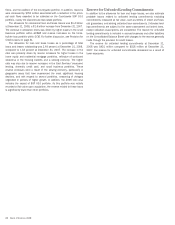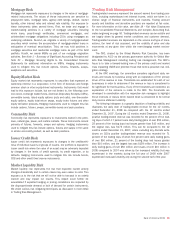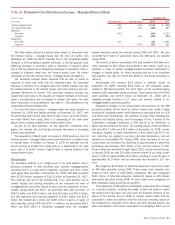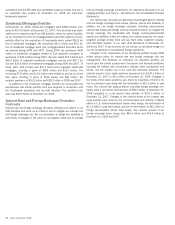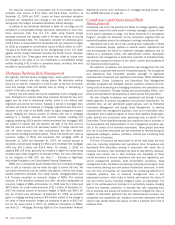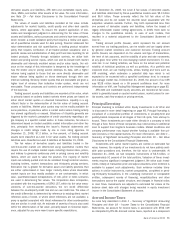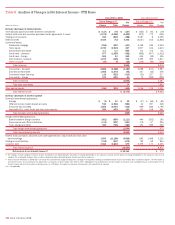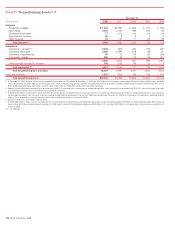Bank of America 2008 Annual Report Download - page 94
Download and view the complete annual report
Please find page 94 of the 2008 Bank of America annual report below. You can navigate through the pages in the report by either clicking on the pages listed below, or by using the keyword search tool below to find specific information within the annual report.The amounts included in accumulated OCI for terminated derivative
contracts were losses of $3.4 billion and $3.8 billion, net-of-tax, at
December 31, 2008 and 2007. Losses on these terminated derivative
contracts are reclassified into earnings in the same period or periods
during which the hedged forecasted transaction affects earnings.
In addition to the derivatives disclosed in Table 42, we hedge our net
investment in consolidated foreign operations determined to have func-
tional currencies other than the U.S. dollar using forward foreign
exchange contracts that typically settle in 90 days as well as by issuing
foreign-denominated debt. The Corporation recorded net derivative gains
of $2.8 billion in accumulated OCI associated with net investment hedges
for 2008 as compared to net derivative losses of $516 million for 2007.
The gains for 2008 were driven by the strengthening of the U.S. dollar
against certain foreign currencies including the British Pound, Canadian
Dollar and the Euro. These gains were more than offset by losses from
the changes in the value of our net investments in consolidated foreign
entities resulting in $1.0 billion in unrealized losses, net-of-tax, that were
recorded in accumulated OCI for 2008.
Mortgage Banking Risk Management
We originate, fund and service mortgage loans, which subject us to credit,
liquidity and interest rate risks, among others. We determine whether
loans will be held for investment or held for sale at the time of commit-
ment and manage credit and liquidity risks by selling or securitizing a
portion of the loans we originate.
Interest rate and market risk can be substantial in the mortgage busi-
ness. Fluctuations in interest rates drive consumer demand for new mort-
gages and the level of refinancing activity, which in turn affects total
origination and service fee income. Typically, a decline in mortgage inter-
est rates will lead to an increase in mortgage originations and fees and a
decrease in the value of the MSRs driven by higher prepayment expect-
ations. Hedging the various sources of interest rate risk in mortgage
banking is a complex process that requires complex modeling and
ongoing monitoring. IRLCs and the related residential first mortgage LHFS
are subject to interest rate risk between the date of the IRLC and the
date the loans are sold to the secondary market. To hedge interest rate
risk, we utilize forward loan sale commitments and other derivative
instruments including purchased options. These instruments are used as
economic hedges of IRLCs and residential first mortgage LHFS. At
December 31, 2008 and December 31, 2007, the notional amount of
derivatives economically hedging the IRLCs and residential first mortgage
LHFS was $97.2 billion and $18.6 billion. On January 1, 2008, we
adopted SAB 109 which generally has resulted in higher fair values being
recorded upon initial recognition of derivative IRLCs. For more information
on the adoption of SAB 109, see Note 1 –Summary of Significant
Accounting Principles to the Consolidated Financial Statements.
MSRs are a nonfinancial asset created when the underlying mortgage
loan is sold to investors and we retain the right to service the loan. We
use certain derivatives such as interest rate options, interest rate swaps,
forward settlement contracts, euro dollar futures, mortgage-backed and
U.S. Treasury securities as economic hedges of MSRs. The notional
amounts of the derivative contracts and other securities designated as
economic hedges of MSRs at December 31, 2008 were $1.0 trillion and
$87.5 billion, for a total notional amount of $1.1 trillion. At December 31,
2007 the notional amount of economic hedges of MSRs was $69.0 bil-
lion, all of which were derivatives. At December 31, 2008, we recorded
gains in mortgage banking income of $8.6 billion related to the change in
fair value of these economic hedges as compared to gains of $303 mil-
lion for the same period in 2007. For additional information on MSRs,
see Note 21 – Mortgage Servicing Rights to the Consolidated Financial
Statements and for more information on mortgage banking income, see
the GCSBB discussion on page 33.
Compliance and Operational Risk
Management
Compliance risk is the risk posed by the failure to manage regulatory, legal
and ethical issues that could result in monetary damages, losses or harm
to the bank’s reputation or image. The Seven Elements of a Compliance
Program
®
provides the framework for the compliance programs that are
consistently applied across the enterprise to manage compliance risk.
Operational risk is the risk of loss resulting from inadequate or failed
internal processes, people, systems or external events. Operational risk
also encompasses the failure to implement strategic objectives and ini-
tiatives in a successful, timely, and cost-effective manner. Successful
operational risk management is particularly important to diversified finan-
cial services companies because of the nature, volume and complexity of
the financial services business.
We approach compliance and operational risk management from two
perspectives: corporate-wide and line of business-specific. The Compliance
and Operational Risk Committee provides oversight of significant
corporate-wide compliance and operational risk issues. Within Global Risk
Management, Global Compliance and Operational Risk Management
develops and guides the strategies, policies, practices, controls and mon-
itoring tools for assessing and managing compliance and operational risks
across the Corporation. Through training and communication efforts, com-
pliance and operational risk awareness is driven across the Corporation.
We also mitigate compliance and operational risk through a broad-
based approach to process management and process improvement. For
selected risks, we use specialized support groups, such as Enterprise
Information Management and Supply Chain Management, to develop
corporate-wide risk management practices, such as an information secu-
rity program and a supplier program to ensure that suppliers adopt appro-
priate policies and procedures when performing work on behalf of the
Corporation. These specialized groups also assist the lines of business in
the development and implementation of risk management practices spe-
cific to the needs of the individual businesses. These groups also work
with line of business executives and risk executives to develop and guide
appropriate strategies, policies, practices, controls and monitoring tools
for each line of business.
The lines of business are responsible for all the risks within the busi-
ness line, including compliance and operational risks. Compliance and
Operational Risk executives, working in conjunction with senior line of
business executives, have developed key tools to help identify, measure,
mitigate and monitor risk in each business line. Examples of these
include processes to ensure compliance with laws and regulations, per-
sonnel management practices, data reconciliation processes, fraud
management units, transaction processing monitoring and analysis, busi-
ness recovery planning and new product introduction processes. In addi-
tion, the lines of business are responsible for monitoring adherence to
corporate practices. Line of business management uses a self-
assessment process, which helps to identify and evaluate the status of
risk and control issues, including mitigation plans, as appropriate. The
goal of the self-assessment process is to periodically assess changing
market and business conditions, to evaluate key risks impacting each
line of business and assess the controls in place to mitigate the risks. In
addition to information gathered from the self-assessment process, key
compliance and operational risk indicators have been developed and are
used to help identify trends and issues on both a corporate and a line of
business level.
92
Bank of America 2008


